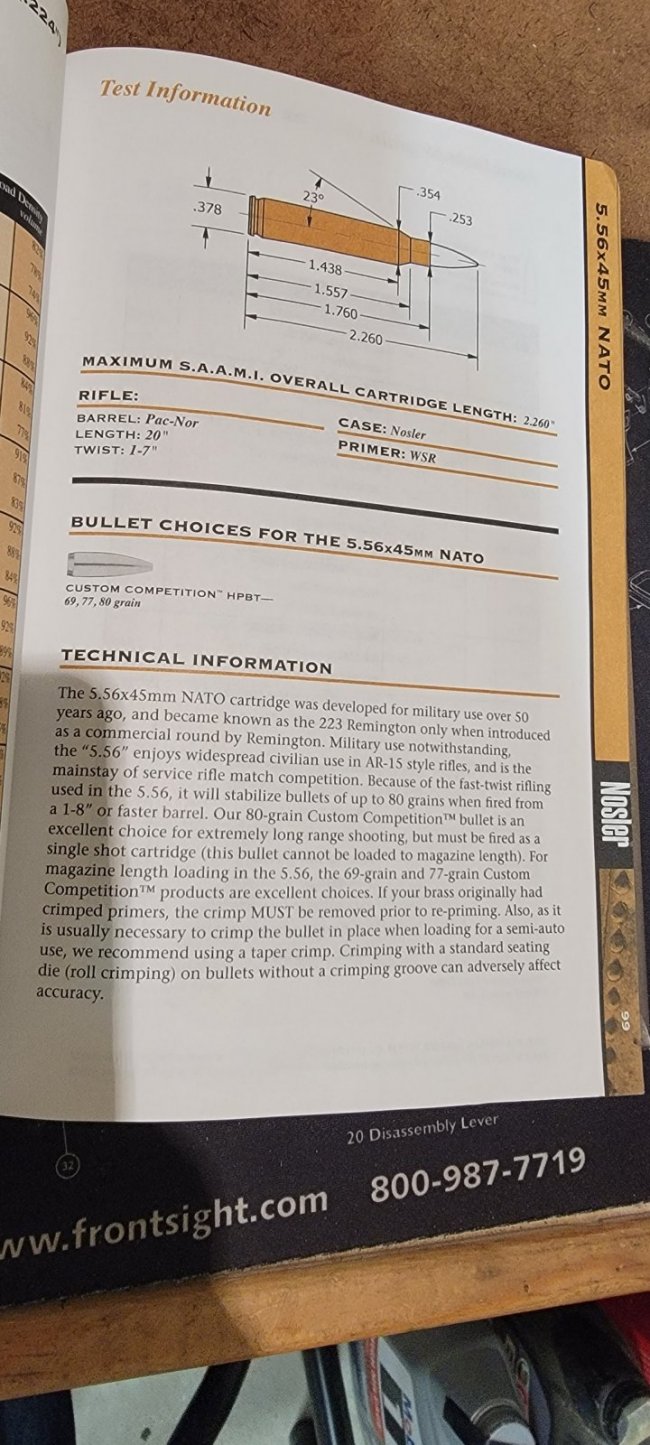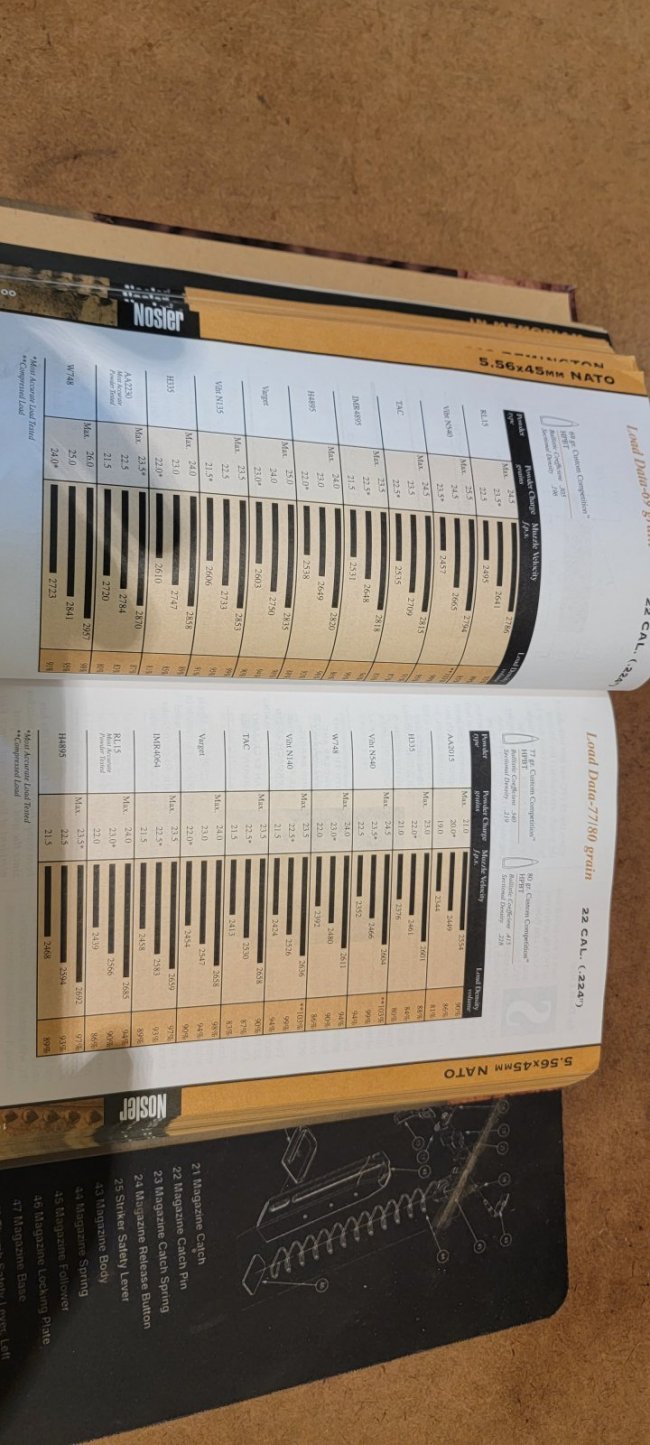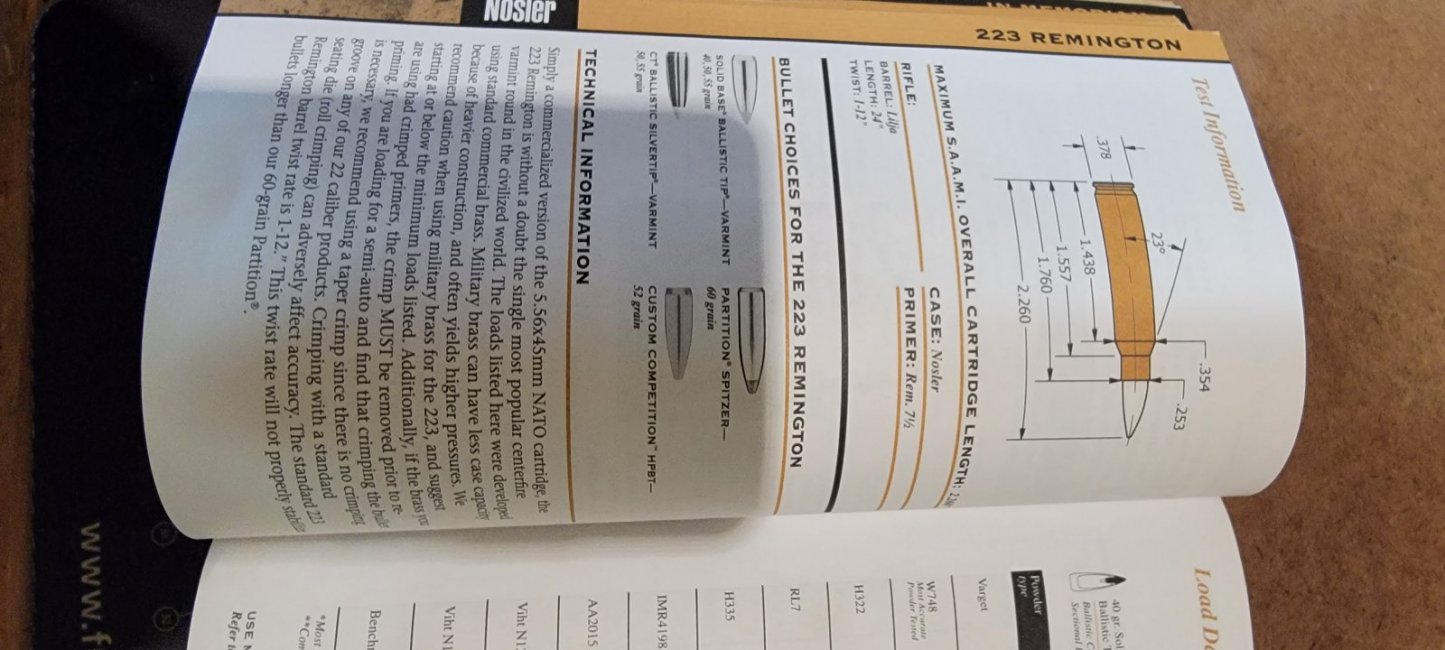You are using an out of date browser. It may not display this or other websites correctly.
You should upgrade or use an alternative browser.
You should upgrade or use an alternative browser.
556 ammo question
- Thread starter alanwk
- Start date
The #1 community for Gun Owners in Texas
Member Benefits:
Fewer Ads! Discuss all aspects of firearm ownership Discuss anti-gun legislation Buy, sell, and trade in the classified section Chat with Local gun shops, ranges, trainers & other businesses Discover free outdoor shooting areas View up to date on firearm-related events Share photos & video with other members ...and so much more!
Member Benefits:
- Status
- Not open for further replies.
Lonesome Dove
A man of vision but with no mission.
I load to 223 specs and call it good.
Everything is the same except for bullet weights. Thats all that needs to be taken into account.
Per Noslers 6th edition
Everything is the same except for bullet weights. Thats all that needs to be taken into account.
Per Noslers 6th edition
Attachments
Last edited:
Years ago Sierra published some AR specific data. Naturally using their bullets. It has all the classics but very few newer powders. Just about all of it is ranged a little higher than similar 223 data out of most manuals. If you poke around you should be able to find it. I think it has data for aa2230, h335, TAC, benchmark and a few others but nothing for cfe223 or other powders more recently produced than that.
5.56 and 223Rem load data are not the same because the way the pressure is measured is different between the SAAMI and NATO specification. There are a few differences such as the MAP pressure value, the transducer location, and a port requirement for the latter. That means that there is not perfect equivalence between them even though they may seem similar and that is ignoring chamber differences. In general, for the same projectile, primer, and powder type, the 5.56 data will have a higher powder charge and velocity because of those differences. Accurate used to have both standards published in their guides, which was useful.
Do you reload? This isn’t really applicable. My Lyman manual publishes .223 data. My hornady manual publishes both. The difference? 5.56 is just the two heaviest bullets. The min and max charged are both lower than Lyman’s .223 loads for the same bullet weight.5.56 and 223Rem load data are not the same because the way the pressure is measured is different between the SAAMI and NATO specification. There are a few differences such as the MAP pressure value, the transducer location, and a port requirement for the latter. That means that there is not perfect equivalence between them even though they may seem similar and that is ignoring chamber differences. In general, for the same projectile, primer, and powder type, the 5.56 data will have a higher powder charge and velocity because of those differences. Accurate used to have both standards published in their guides, which was useful.
He loads more in a day than I'll load in a decade.Do you reload? This isn’t really applicable. My Lyman manual publishes .223 data. My hornady manual publishes both. The difference? 5.56 is just the two heaviest bullets. The min and max charged are both lower than Lyman’s .223 loads for the same bullet weight.
Without any point of reference that doesn’t tell me anything.He loads more in a day than I'll load in a decade.
Do you reload? This isn’t really applicable. My Lyman manual publishes .223 data. My hornady manual publishes both. The difference? 5.56 is just the two heaviest bullets. The min and max charged are both lower than Lyman’s .223 loads for the same bullet weight.
Yes, as a matter of fact I do reload a little bit but the question from the OP doesn't requires knowledge of reloading to answer it. It is more useful to understand the testing procedures used to measure pressure in those two cartridges and know the differences between them to answer that question. Sure, being a reloader who has read a few reloading manuals might make one think they are an expert and that they know everything they need but that certainly hasn't been the case for me. While it is true that I probably load more ammunition in a day than most of you do in a decade, that isn't relevant to the OP's question or to my answer.
Your observation about your specific loading manuals may be true but it doesn't negate anything that I wrote in response to the OP or facts about those two cartridge designations. You aren't even addressing the issue but rather conflating an entirely different issue with the 223/5.56 differences. Briefly, every loading manual is different for a variety of reasons, least among them the difference in pressure barrels condition/erosion, transducer offsets, brass lots, powder lots, primer lots, testing procedures, testing type (crusher or transducer), conditioning procedures, adherence to the published testing standards, and their own procedures for taking and publishing data they consider safe. That is another issue entirely and not particularly germane to the OP's question. Although it is an interesting discussion and you could open another thread to discuss if you'd like.
I'll say it again so there is no confusion about what I meant for the OP. There are two different specifications for 223Rem (SAAMI) and 5.56 (NATO) that we are discussing here and they are NOT the same thing. Most manuals published for reloaders in the US rely on the SAAMI specifications (Z299) for pressure barrel setup, taking pressure data, and interpreting those data. Since 5.56 is NOT a SAAMI approved cartridge, if your lab follows only SAAMI protocol then naturally they won't have 5.56 data in the loading manual it produces. You can't simply say something asinine like, SAAMI MAP is xyz and NATO is 123, so I'll just put in a little more powder and when my transducer gives me 123 I have the 5.56 data!
In case you are interested in learning something about the standards and how they are used to measure pressure for safe loads, start here for SAAMI
start here for the NATO spec
pay particular attention to how the data are analyzed, outliers are handled, rounding is handled, the conditioning procedures, the calibration procedures, transducer locations, barrel construction, and all the other great info in there. It's a lot to distill down into a small forum post but hopefully this post is clearer than my last.
Lonesome Dove
A man of vision but with no mission.
OP if you really need or desire 5.56 just buy 5.56 ammo.
I didn’t address the issue because there was no issue. If you pick your brass, primer, powder, and bullet, whether you use 5.56 or .223 data, you will end up at the same result when you finish working up your load. That’s why people don’t need to worry about different sets of data.Yes, as a matter of fact I do reload a little bit but the question from the OP doesn't requires knowledge of reloading to answer it. It is more useful to understand the testing procedures used to measure pressure in those two cartridges and know the differences between them to answer that question. Sure, being a reloader who has read a few reloading manuals might make one think they are an expert and that they know everything they need but that certainly hasn't been the case for me. While it is true that I probably load more ammunition in a day than most of you do in a decade, that isn't relevant to the OP's question or to my answer.
Your observation about your specific loading manuals may be true but it doesn't negate anything that I wrote in response to the OP or facts about those two cartridge designations. You aren't even addressing the issue but rather conflating an entirely different issue with the 223/5.56 differences. Briefly, every loading manual is different for a variety of reasons, least among them the difference in pressure barrels condition/erosion, transducer offsets, brass lots, powder lots, primer lots, testing procedures, testing type (crusher or transducer), conditioning procedures, adherence to the published testing standards, and their own procedures for taking and publishing data they consider safe. That is another issue entirely and not particularly germane to the OP's question. Although it is an interesting discussion and you could open another thread to discuss if you'd like.
I'll say it again so there is no confusion about what I meant for the OP. There are two different specifications for 223Rem (SAAMI) and 5.56 (NATO) that we are discussing here and they are NOT the same thing. Most manuals published for reloaders in the US rely on the SAAMI specifications (Z299) for pressure barrel setup, taking pressure data, and interpreting those data. Since 5.56 is NOT a SAAMI approved cartridge, if your lab follows only SAAMI protocol then naturally they won't have 5.56 data in the loading manual it produces. You can't simply say something asinine like, SAAMI MAP is xyz and NATO is 123, so I'll just put in a little more powder and when my transducer gives me 123 I have the 5.56 data!
In case you are interested in learning something about the standards and how they are used to measure pressure for safe loads, start here for SAAMI
start here for the NATO spec
pay particular attention to how the data are analyzed, outliers are handled, rounding is handled, the conditioning procedures, the calibration procedures, transducer locations, barrel construction, and all the other great info in there. It's a lot to distill down into a small forum post but hopefully this post is clearer than my last.
cycleguy2300
TGT Addict
It means he reloads a lot...Without any point of reference that doesn’t tell me anything.
Sent from my SM-S918B using Tapatalk
“A lot” is relative. His post read like he didn’t, therefore, I asked.It means he reloads a lot...
Sent from my SM-S918B using Tapatalk
Let’s just say he’s an actual professional loader.“A lot” is relative. His post read like he didn’t, therefore, I asked.
Best I can do is 60 rounds in 5 minutes. After I'm in a groove and the progressive press is happy.
Deavis can cover that in seconds.
Any further "sources or links" are not offered by me.
Believe it or not.
Deavis can cover that in seconds.
Any further "sources or links" are not offered by me.
Believe it or not.
cycleguy2300
TGT Addict
A plain reading would indicate substantial, even massive round counts... his post read like he knew his stuff and yours read like youre being havok and trying to throw shade at anyone who actually knows wtf they are talking about, which historically backfires on ya.“A lot” is relative. His post read like he didn’t, therefore, I asked.
Sent from my SM-S918B using Tapatalk
Honest wasn’t really about what the OP asked. Someone who is not a reloader may understand the differences between .223 and 5.56 but not understand why a company would not feel the need to publish two different sets of data.A plain reading would indicate substantial, even massive round counts... his post read like he knew his stuff and yours read like youre being havok and trying to throw shade at anyone who actually knows wtf they are talking about, which historically backfires on ya.
Sent from my SM-S918B using Tapatalk
- Status
- Not open for further replies.
Staff online
-
robertc1024Moderator
Members online
- MountainGirl
- Me
- glazer1972
- Ingramite
- McCrapper
- Jhatt
- HKaltwasser
- brashears9567
- skfullgun
- 10-96inTexas
- jetcycles
- chapel3929
- CJGarza
- BuzzinSATX
- BeatTheTunaUp
- Kudu61
- Txhighlander
- RickLovesBacon
- msharley
- Big Dipper
- jedwil
- big_bad_kitty
- jlw
- dzet
- leonidas
- zackmars
- TipBledsoe
- Southpaw
- crzy_one
- tkundert2
- Hoji
- robertc1024
- Wmb556
- Charley
- Cool 'Horn Luke
- vichltn45
- digger
- Txmark
- oldguy
- El Coyote
- Ioannes
- dsgrey
- ronr68
- RedCherokee
- Big Green
- TwentyFive
- paknheat
- gasgas
- lbbf
- Saguy46
Total: 1,209 (members: 66, guests: 1,143)









